sensor LINCOLN MKC 2016 Service Manual
[x] Cancel search | Manufacturer: LINCOLN, Model Year: 2016, Model line: MKC, Model: LINCOLN MKC 2016Pages: 432, PDF Size: 4.89 MB
Page 228 of 432
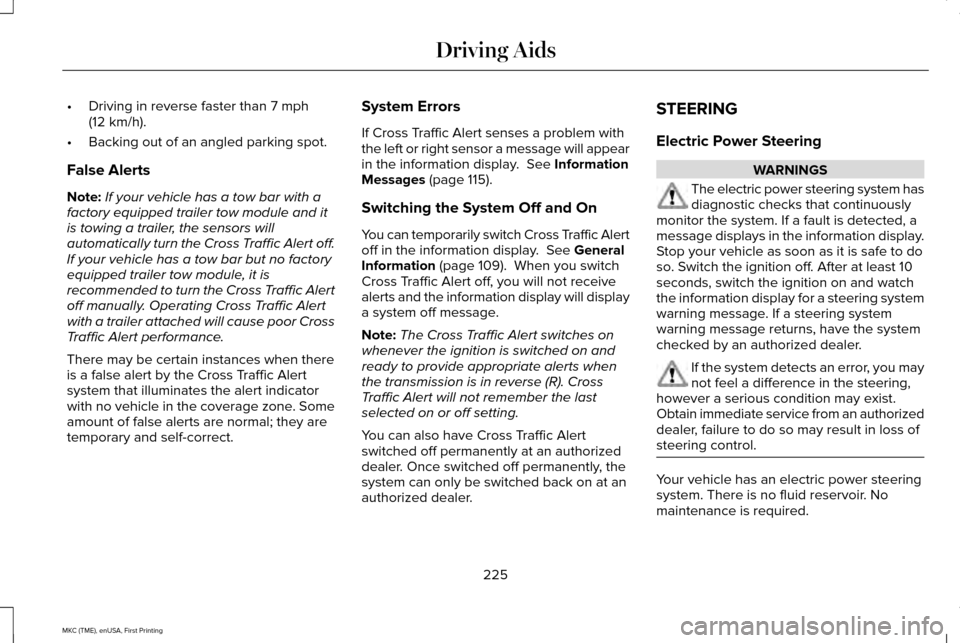
•
Driving in reverse faster than 7 mph
(12 km/h).
• Backing out of an angled parking spot.
False Alerts
Note: If your vehicle has a tow bar with a
factory equipped trailer tow module and it
is towing a trailer, the sensors will
automatically turn the Cross Traffic Alert off.
If your vehicle has a tow bar but no factory
equipped trailer tow module, it is
recommended to turn the Cross Traffic Alert
off manually. Operating Cross Traffic Alert
with a trailer attached will cause poor Cross
Traffic Alert performance.
There may be certain instances when there
is a false alert by the Cross Traffic Alert
system that illuminates the alert indicator
with no vehicle in the coverage zone. Some
amount of false alerts are normal; they are
temporary and self-correct. System Errors
If Cross Traffic Alert senses a problem with
the left or right sensor a message will appear
in the information display.
See Information
Messages (page 115).
Switching the System Off and On
You can temporarily switch Cross Traffic Alert
off in the information display.
See General
Information (page 109). When you switch
Cross Traffic Alert off, you will not receive
alerts and the information display will display
a system off message.
Note: The Cross Traffic Alert switches on
whenever the ignition is switched on and
ready to provide appropriate alerts when
the transmission is in reverse (R). Cross
Traffic Alert will not remember the last
selected on or off setting.
You can also have Cross Traffic Alert
switched off permanently at an authorized
dealer. Once switched off permanently, the
system can only be switched back on at an
authorized dealer. STEERING
Electric Power Steering WARNINGS
The electric power steering system has
diagnostic checks that continuously
monitor the system. If a fault is detected, a
message displays in the information display.
Stop your vehicle as soon as it is safe to do
so. Switch the ignition off. After at least 10
seconds, switch the ignition on and watch
the information display for a steering system
warning message. If a steering system
warning message returns, have the system
checked by an authorized dealer. If the system detects an error, you may
not feel a difference in the steering,
however a serious condition may exist.
Obtain immediate service from an authorized
dealer, failure to do so may result in loss of
steering control. Your vehicle has an electric power steering
system. There is no fluid reservoir. No
maintenance is required.
225
MKC (TME), enUSA, First Printing Driving Aids
Page 230 of 432

The system alerts you of certain collision
risks. The system's sensor detects your
vehicle's rapid approach to other vehicles
traveling in the same direction as your
vehicle.
When your vehicle rapidly approaches
another vehicle, a red warning light flashes
and a tone sounds. The brake support system assists you in
reducing any collision speed by pre-charging
the brakes. If the risk of collision continues
to increases after the audio-visual warning,
the brake support prepares the brake system
for rapid braking. The system does not
automatically activate the brakes, but if the
brake pedal is pressed even lightly, the
brakes apply full stopping power.
Using the Collision Warning System
WARNING
The collision warning system
’s brake
support reduces collision speed only
if you brake your vehicle before any collision.
As in any typical braking situation, you must
press your brake pedal. You can use your information display control
to adjust the warning system's sensitivity to
any one of three possible settings. See
General Information (page 109). Note:
When possible, the manufacturer
recommends using the highest sensitivity
setting. If warnings are too frequent, you can
reduce your system's sensitivity. Reduced
sensitivity causes fewer and later system
warnings.
See General Information (page
109).
Blocked Sensors If a blocked sensor message appears in the
information display, dirt, water, or an object
is blocking the sensor. The sensor is located
behind a cover near the driver side of the
lower grille. If anything blocks the sensor,
your vehicle cannot see through the sensor,
and the collision warning system will not
work. Possible causes for the blocked sensor
message and corrective actions are listed
below.
227
MKC (TME), enUSA, First Printing Driving AidsE156130 E156131 E145632
Page 231 of 432
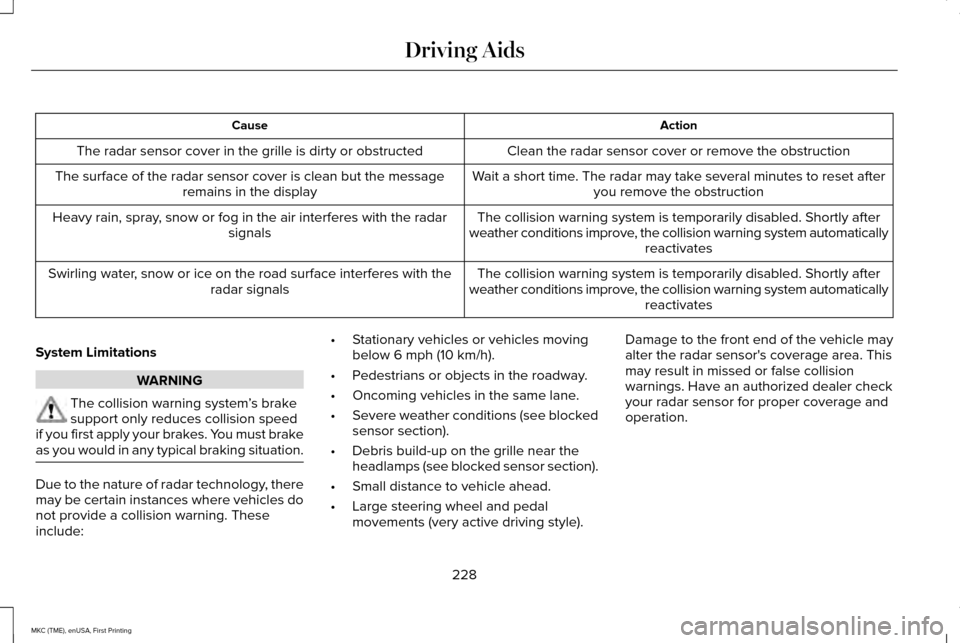
Action
Cause
Clean the radar sensor cover or remove the obstruction
The radar sensor cover in the grille is dirty or obstructed
Wait a short time. The radar may take several minutes to reset afteryou remove the obstruction
The surface of the radar sensor cover is clean but the message
remains in the display
The collision warning system is temporarily disabled. Shortly after
weather conditions improve, the collision warning system automatically reactivates
Heavy rain, spray, snow or fog in the air interferes with the radar
signals
The collision warning system is temporarily disabled. Shortly after
weather conditions improve, the collision warning system automatically reactivates
Swirling water, snow or ice on the road surface interferes with the
radar signals
System Limitations WARNING
The collision warning system
’s brake
support only reduces collision speed
if you first apply your brakes. You must brake
as you would in any typical braking situation. Due to the nature of radar technology, there
may be certain instances where vehicles do
not provide a collision warning. These
include: •
Stationary vehicles or vehicles moving
below 6 mph (10 km/h).
• Pedestrians or objects in the roadway.
• Oncoming vehicles in the same lane.
• Severe weather conditions (see blocked
sensor section).
• Debris build-up on the grille near the
headlamps (see blocked sensor section).
• Small distance to vehicle ahead.
• Large steering wheel and pedal
movements (very active driving style). Damage to the front end of the vehicle may
alter the radar sensor's coverage area. This
may result in missed or false collision
warnings. Have an authorized dealer check
your radar sensor for proper coverage and
operation.
228
MKC (TME), enUSA, First Printing Driving Aids
Page 272 of 432
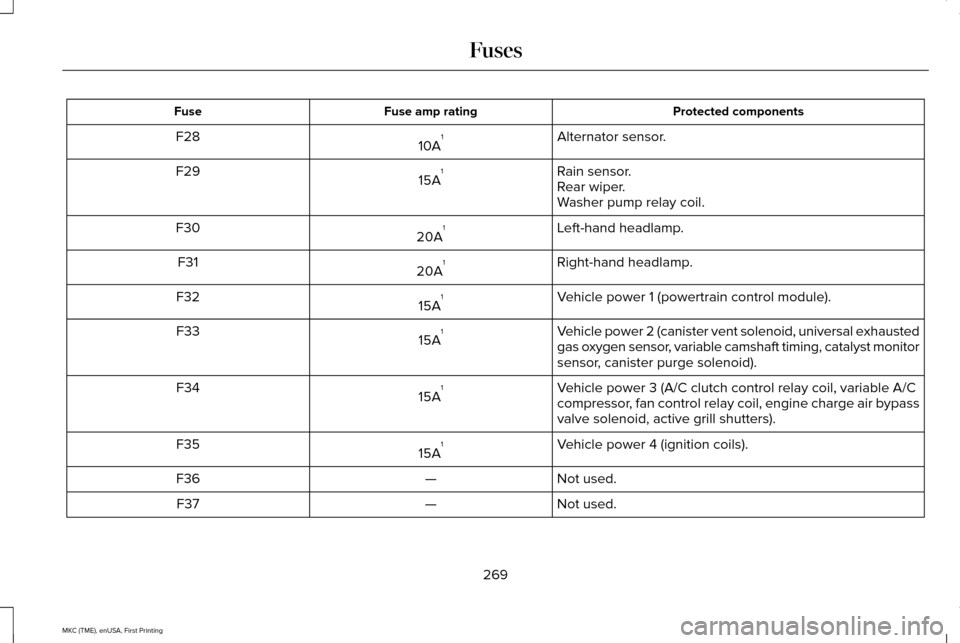
Protected components
Fuse amp rating
Fuse
Alternator sensor.
10A 1
F28
Rain sensor.
15A 1
F29
Rear wiper.
Washer pump relay coil.
Left-hand headlamp.
20A 1
F30
Right-hand headlamp.
20A 1
F31
Vehicle power 1 (powertrain control module).
15A 1
F32
Vehicle power 2 (canister vent solenoid, universal exhausted
gas oxygen sensor, variable camshaft timing, catalyst monitor
sensor, canister purge solenoid).
15A
1
F33
Vehicle power 3 (A/C clutch control relay coil, variable A/C
compressor, fan control relay coil, engine charge air bypass
valve solenoid, active grill shutters).
15A
1
F34
Vehicle power 4 (ignition coils).
15A 1
F35
Not used.
—
F36
Not used.
—
F37
269
MKC (TME), enUSA, First Printing Fuses
Page 278 of 432
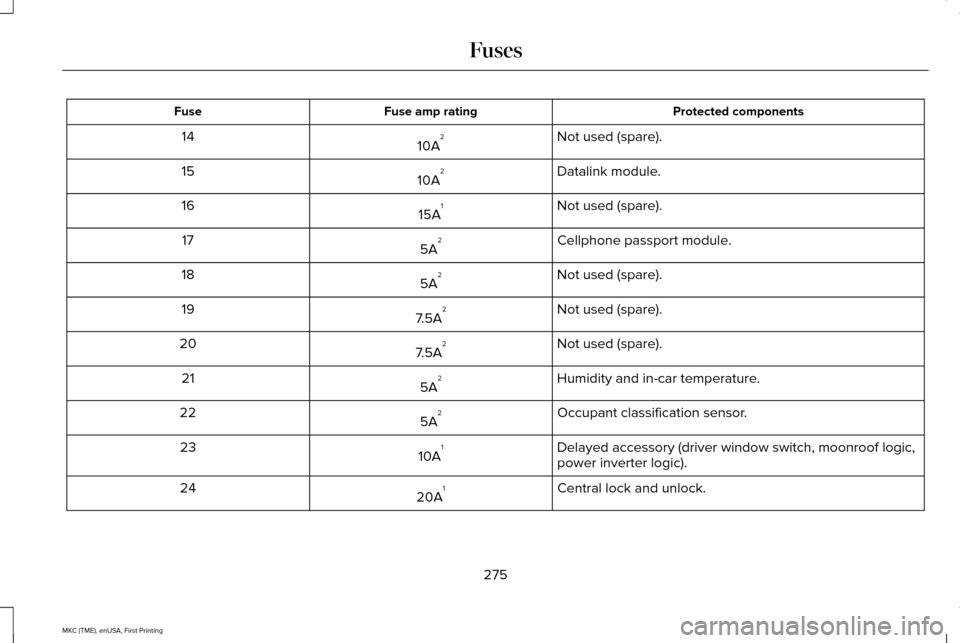
Protected components
Fuse amp rating
Fuse
Not used (spare).
10A 2
14
Datalink module.
10A 2
15
Not used (spare).
15A 1
16
Cellphone passport module.
5A 2
17
Not used (spare).
5A 2
18
Not used (spare).
7.5A 2
19
Not used (spare).
7.5A 2
20
Humidity and in-car temperature.
5A 2
21
Occupant classification sensor.
5A 2
22
Delayed accessory (driver window switch, moonroof logic,
power inverter logic).
10A 1
23
Central lock and unlock.
20A 1
24
275
MKC (TME), enUSA, First Printing Fuses
Page 330 of 432
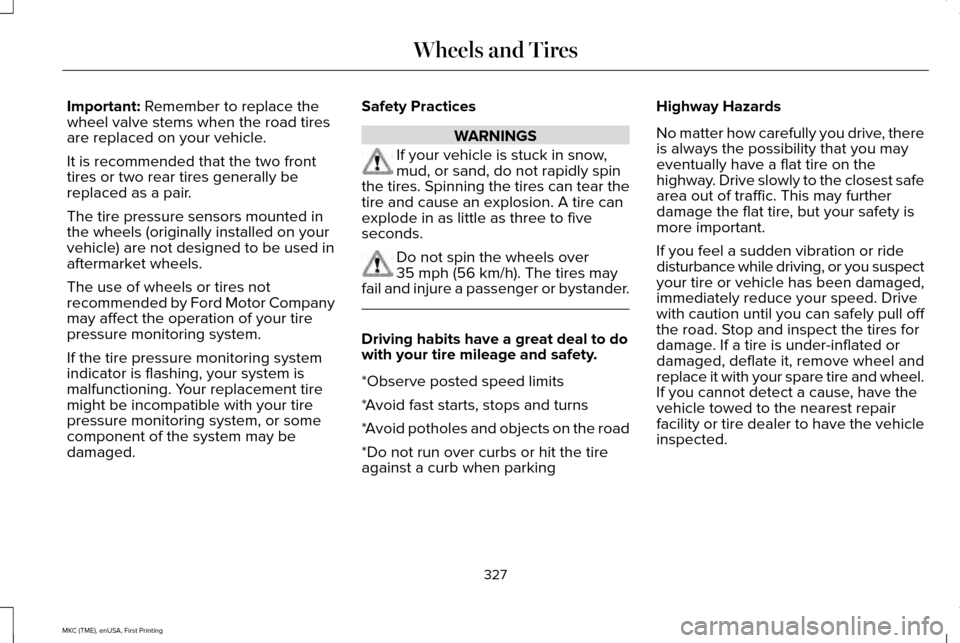
Important: Remember to replace the
wheel valve stems when the road tires
are replaced on your vehicle.
It is recommended that the two front
tires or two rear tires generally be
replaced as a pair.
The tire pressure sensors mounted in
the wheels (originally installed on your
vehicle) are not designed to be used in
aftermarket wheels.
The use of wheels or tires not
recommended by Ford Motor Company
may affect the operation of your tire
pressure monitoring system.
If the tire pressure monitoring system
indicator is flashing, your system is
malfunctioning. Your replacement tire
might be incompatible with your tire
pressure monitoring system, or some
component of the system may be
damaged. Safety Practices WARNINGS
If your vehicle is stuck in snow,
mud, or sand, do not rapidly spin
the tires. Spinning the tires can tear the
tire and cause an explosion. A tire can
explode in as little as three to five
seconds. Do not spin the wheels over
35 mph (56 km/h)
. The tires may
fail and injure a passenger or bystander. Driving habits have a great deal to do
with your tire mileage and safety.
*Observe posted speed limits
*Avoid fast starts, stops and turns
*Avoid potholes and objects on the road
*Do not run over curbs or hit the tire
against a curb when parkingHighway Hazards
No matter how carefully you drive, there
is always the possibility that you may
eventually have a flat tire on the
highway. Drive slowly to the closest safe
area out of traffic. This may further
damage the flat tire, but your safety is
more important.
If you feel a sudden vibration or ride
disturbance while driving, or you suspect
your tire or vehicle has been damaged,
immediately reduce your speed. Drive
with caution until you can safely pull off
the road. Stop and inspect the tires for
damage. If a tire is under-inflated or
damaged, deflate it, remove wheel and
replace it with your spare tire and wheel.
If you cannot detect a cause, have the
vehicle towed to the nearest repair
facility or tire dealer to have the vehicle
inspected.
327
MKC (TME), enUSA, First Printing Wheels and Tires
Page 334 of 432
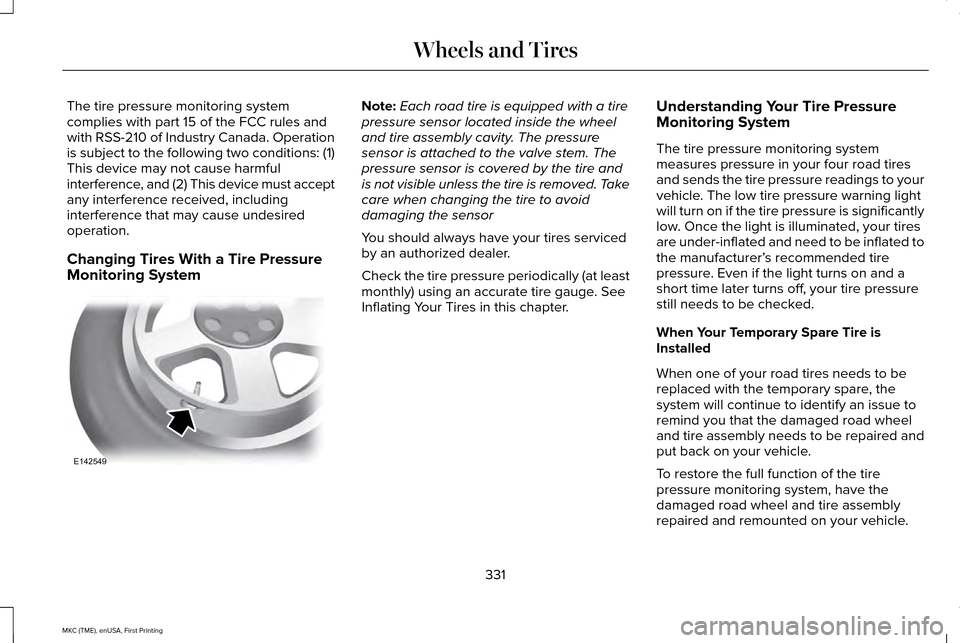
The tire pressure monitoring system
complies with part 15 of the FCC rules and
with RSS-210 of Industry Canada. Operation
is subject to the following two conditions: (1)
This device may not cause harmful
interference, and (2) This device must accept
any interference received, including
interference that may cause undesired
operation.
Changing Tires With a Tire Pressure
Monitoring System Note:
Each road tire is equipped with a tire
pressure sensor located inside the wheel
and tire assembly cavity. The pressure
sensor is attached to the valve stem. The
pressure sensor is covered by the tire and
is not visible unless the tire is removed. Take
care when changing the tire to avoid
damaging the sensor
You should always have your tires serviced
by an authorized dealer.
Check the tire pressure periodically (at least
monthly) using an accurate tire gauge. See
Inflating Your Tires in this chapter. Understanding Your Tire Pressure
Monitoring System
The tire pressure monitoring system
measures pressure in your four road tires
and sends the tire pressure readings to your
vehicle. The low tire pressure warning light
will turn on if the tire pressure is significantly
low. Once the light is illuminated, your tires
are under-inflated and need to be inflated to
the manufacturer’
s recommended tire
pressure. Even if the light turns on and a
short time later turns off, your tire pressure
still needs to be checked.
When Your Temporary Spare Tire is
Installed
When one of your road tires needs to be
replaced with the temporary spare, the
system will continue to identify an issue to
remind you that the damaged road wheel
and tire assembly needs to be repaired and
put back on your vehicle.
To restore the full function of the tire
pressure monitoring system, have the
damaged road wheel and tire assembly
repaired and remounted on your vehicle.
331
MKC (TME), enUSA, First Printing Wheels and TiresE142549
Page 337 of 432
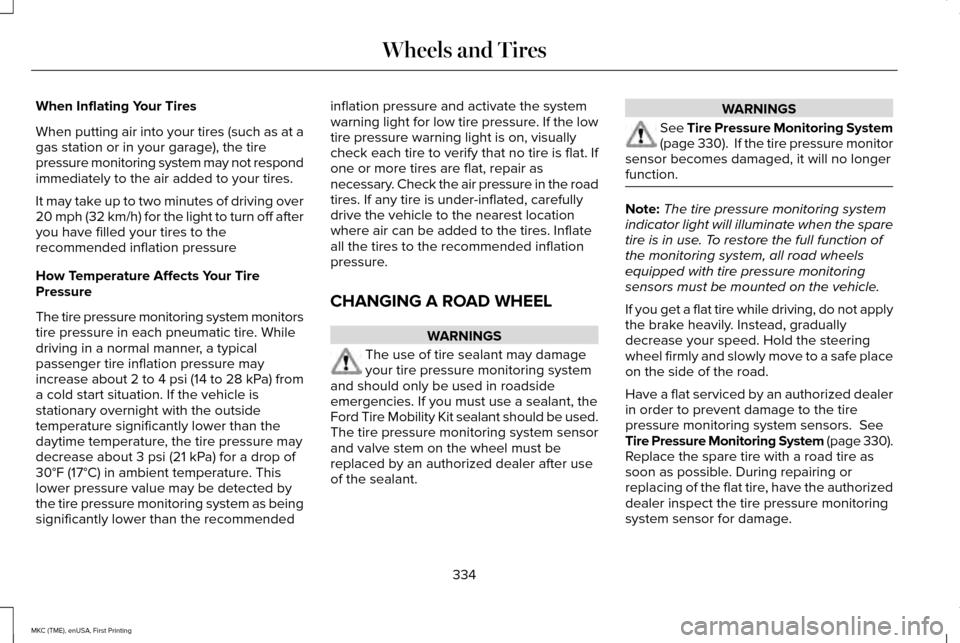
When Inflating Your Tires
When putting air into your tires (such as at a
gas station or in your garage), the tire
pressure monitoring system may not respond
immediately to the air added to your tires.
It may take up to two minutes of driving over
20 mph (32 km/h) for the light to turn off after
you have filled your tires to the
recommended inflation pressure
How Temperature Affects Your Tire
Pressure
The tire pressure monitoring system monitors
tire pressure in each pneumatic tire. While
driving in a normal manner, a typical
passenger tire inflation pressure may
increase about 2 to 4 psi (14 to 28 kPa) from
a cold start situation. If the vehicle is
stationary overnight with the outside
temperature significantly lower than the
daytime temperature, the tire pressure may
decrease about 3 psi (21 kPa) for a drop of
30°F (17°C) in ambient temperature. This
lower pressure value may be detected by
the tire pressure monitoring system as being
significantly lower than the recommended
inflation pressure and activate the system
warning light for low tire pressure. If the low
tire pressure warning light is on, visually
check each tire to verify that no tire is flat. If
one or more tires are flat, repair as
necessary. Check the air pressure in the road
tires. If any tire is under-inflated, carefully
drive the vehicle to the nearest location
where air can be added to the tires. Inflate
all the tires to the recommended inflation
pressure.
CHANGING A ROAD WHEEL
WARNINGS
The use of tire sealant may damage
your tire pressure monitoring system
and should only be used in roadside
emergencies. If you must use a sealant, the
Ford Tire Mobility Kit sealant should be used.
The tire pressure monitoring system sensor
and valve stem on the wheel must be
replaced by an authorized dealer after use
of the sealant. WARNINGS
See Tire Pressure Monitoring System
(page 330). If the tire pressure monitor
sensor becomes damaged, it will no longer
function. Note:
The tire pressure monitoring system
indicator light will illuminate when the spare
tire is in use. To restore the full function of
the monitoring system, all road wheels
equipped with tire pressure monitoring
sensors must be mounted on the vehicle.
If you get a flat tire while driving, do not apply
the brake heavily. Instead, gradually
decrease your speed. Hold the steering
wheel firmly and slowly move to a safe place
on the side of the road.
Have a flat serviced by an authorized dealer
in order to prevent damage to the tire
pressure monitoring system sensors. See
Tire Pressure Monitoring System (page 330).
Replace the spare tire with a road tire as
soon as possible. During repairing or
replacing of the flat tire, have the authorized
dealer inspect the tire pressure monitoring
system sensor for damage.
334
MKC (TME), enUSA, First Printing Wheels and Tires
Page 423 of 432
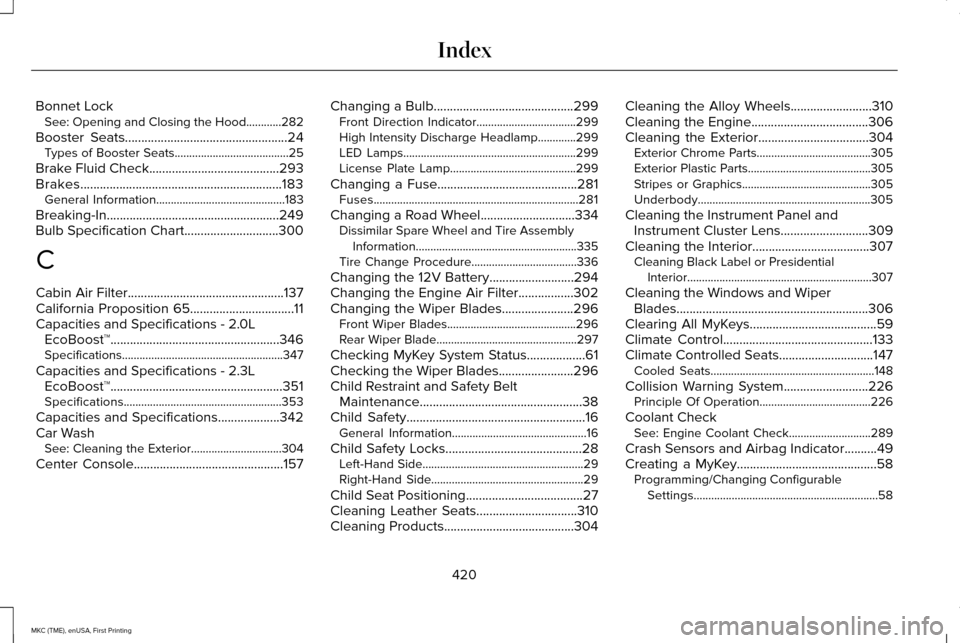
Bonnet Lock
See: Opening and Closing the Hood............282
Booster Seats..................................................24
Types of Booster Seats.......................................25
Brake Fluid Check........................................293
Brakes..............................................................183 General Information............................................183
Breaking-In.....................................................249
Bulb Specification Chart
.............................300
C
Cabin Air Filter................................................137
California Proposition 65................................11
Capacities and Specifications - 2.0L EcoBoost™
....................................................346
Specifications.......................................................347
Capacities and Specifications - 2.3L EcoBoost™.....................................................351
Specifications......................................................353
Capacities and Specifications...................342
Car Wash See: Cleaning the Exterior...............................304
Center Console
..............................................157 Changing a Bulb
...........................................299
Front Direction Indicator..................................299
High Intensity Discharge Headlamp
.............299
LED Lamps...........................................................299
License Plate Lamp...........................................299
Changing a Fuse...........................................281 Fuses......................................................................281
Changing a Road Wheel.............................334 Dissimilar Spare Wheel and Tire Assembly
Information.......................................................335
Tire Change Procedure....................................336
Changing the 12V Battery..........................294
Changing the Engine Air Filter.................302
Changing the Wiper Blades......................296 Front Wiper Blades............................................296
Rear Wiper Blade................................................297
Checking MyKey System Status..................61
Checking the Wiper Blades.......................296
Child Restraint and Safety Belt Maintenance..................................................38
Child Safety
.......................................................16
General Information..............................................16
Child Safety Locks..........................................28 Left-Hand Side.......................................................29
Right-Hand Side....................................................29
Child Seat Positioning
....................................27
Cleaning Leather Seats...............................310
Cleaning Products
........................................304 Cleaning the Alloy Wheels.........................310
Cleaning the Engine....................................306
Cleaning the Exterior
..................................304
Exterior Chrome Parts.......................................305
Exterior Plastic Parts..........................................305
Stripes or Graphics............................................305
Underbody...........................................................305
Cleaning the Instrument Panel and Instrument Cluster Lens...........................309
Cleaning the Interior....................................307 Cleaning Black Label or Presidential
Interior...............................................................307
Cleaning the Windows and Wiper Blades...........................................................306
Clearing All MyKeys.......................................59
Climate Control..............................................133
Climate Controlled Seats.............................147 Cooled Seats........................................................148
Collision Warning System..........................226 Principle Of Operation......................................
226
Coolant Check See: Engine Coolant Check............................289
Crash Sensors and Airbag Indicator
..........49
Creating a MyKey...........................................58 Programming/Changing Configurable
Settings...............................................................58
420
MKC (TME), enUSA, First Printing Index
Page 431 of 432
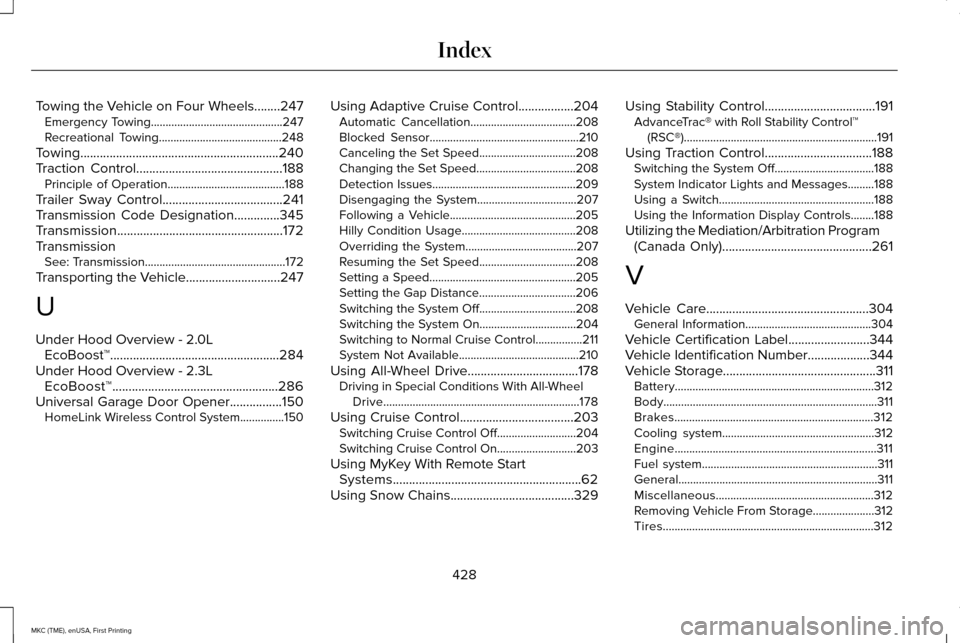
Towing the Vehicle on Four Wheels........247
Emergency Towing.............................................247
Recreational Towing..........................................248
Towing.............................................................240
Traction Control.............................................188
Principle of Operation........................................188
Trailer Sway Control.....................................241
Transmission Code Designation
..............345
Transmission...................................................172
Transmission See: Transmission................................................172
Transporting the Vehicle.............................247
U
Under Hood Overview - 2.0L EcoBoost™....................................................284
Under Hood Overview - 2.3L EcoBoost™...................................................286
Universal Garage Door Opener................150 HomeLink Wireless Control System...............150 Using Adaptive Cruise Control.................204
Automatic Cancellation....................................208
Blocked Sensor...................................................210
Canceling the Set Speed.................................208
Changing the Set Speed..................................208
Detection Issues.................................................209
Disengaging the System..................................207
Following a Vehicle...........................................205
Hilly Condition Usage.......................................208
Overriding the System......................................207
Resuming the Set Speed.................................208
Setting a Speed..................................................205
Setting the Gap Distance.................................206
Switching the System Off.................................208
Switching the System On.................................204
Switching to Normal Cruise Control................211
System Not Available.........................................210
Using All-Wheel Drive
..................................178
Driving in Special Conditions With All-Wheel
Drive...................................................................178
Using Cruise Control...................................203 Switching Cruise Control Off...........................204
Switching Cruise Control On...........................203
Using MyKey With Remote Start Systems..........................................................62
Using Snow Chains......................................329 Using Stability Control..................................191
AdvanceTrac® with Roll Stability Control™
(RSC®)..................................................................191
Using Traction Control.................................188 Switching the System Off..................................188
System Indicator Lights and Messages.........188
Using a Switch.....................................................188
Using the Information Display Controls........
188
Utilizing the Mediation/Arbitration Program (Canada Only)
..............................................261
V
Vehicle Care
..................................................304
General Information...........................................304
Vehicle Certification Label.........................344
Vehicle Identification Number...................344
Vehicle Storage
...............................................311
Battery....................................................................312
Body........................................................................\
.311
Brakes....................................................................312
Cooling system....................................................312
Engine.....................................................................311
Fuel system............................................................311
General....................................................................311
Miscellaneous......................................................312
Removing Vehicle From Storage.....................312
Tires........................................................................\
312
428
MKC (TME), enUSA, First Printing Index